Deposition of Water and Emulsion Hollow Droplets on Hydrophilic and Hydrophobic Surfaces
Abstract
1. Introduction
2. Materials and Methods
2.1. Experimental Equipment and Method
2.2. Numerical Simulation
3. Results and Discussion
3.1. Dense Water Droplet and Hollow Water Droplet Impact on Hydrophilic Surface
3.2. Effect of Bubble Volume on Central Jet Breakup
3.3. Effect of Impact Velocity on Central Jet Breakup
3.3.1. Central Jet Breakup of Hollow Droplet with ~0.05 at Different Impact Velocities
3.3.2. Central Jet Breakup of Hollow Droplet of ~0.2 at Different Impact Velocities
3.4. Effect of Oil-Based Emulsion on the Retention of Hollow Droplets
4. Conclusions
- (1)
- Large bubble volume was responsible for the large attainable height of the central jet. For hollow water droplets with impact velocity of 2.58 m/s, We ranged between 350 and 391, and the bubble volume fraction 0.15 can be roughly defined as a central jet breakup threshold. When the bubble volume fraction varied from 0.03 to 0.15, the central jet breakup was insignificant. When the bubble volume fraction varied from 0.15 to 0.23, the probability of central jet breakup was significantly high. The formation of the central jet depends on the internal pressure difference, which propels the liquid flow from the bottom to the center. The larger the bubble volume, the larger the internal pressure difference, and so the formation of the central jet is more convenient.
- (2)
- The attainable height of the central jet increased with velocity. For hollow droplets with the bubble volume fraction of about 0.05, as We ranged from 200 to 300, central jets were produced, but the jets hardly broke. At We > 300, the central jet breakup was initiated. For hollow droplets with the bubble volume fraction of about 0.2, as We varied from 220 to 300, the central jet breakup was insignificant. As We increased from 320 to 360, the probability of central jet breakup increased. For the hollow droplets with the bubble volume fraction of 0.05 or 0.2, to avoid central jet breakup, We < 300 is recommended. Meanwhile, high impact velocity results in high bottom pressure, and the pressure difference between the bottom and the air cavity is greater. Consequently, the formation of the central jet is accelerated.
- (3)
- Emulsion facilitated the adherence of the hollow droplet to the hydrophobic surface. This was attributed to the infiltration of oil molecules into the hydrophobic surface and the resultant formation of an oil ridge, rather than the surface tension or viscosity. Oil molecules will cause viscous dissipation of the shrinking droplet, coupled with energy loss due to the fingering splash and central jet breakup. Eventually, the rebound of the droplets is restrained by the inhibited force from the oil ridge. The emulsion concentration of 0.4% serves as a turning point at which the behavior of the hollow droplets shifts from rebounding to adhering on the hydrophobic surface.
Author Contributions
Funding
Institutional Review Board Statement
Data Availability Statement
Acknowledgments
Conflicts of Interest
References
- Dai, S.; Wang, M.; Ou, M.; Zhou, H.; Jia, W.; Gao, R.; Wang, C.; Wang, G.; Li, Z.; Chen, H. Development and Experiment of an Online Measuring System for Spray Deposition. Agriculture 2022, 12, 1195. [Google Scholar] [CrossRef]
- Zhou, Q.; Xue, X.; Chen, C.; Cai, C.; Jiao, Y. Canopy deposition characteristics of different orchard pesticide dose models. Int. J. Agric. Biol. Eng. 2023, 16, 1–6. [Google Scholar] [CrossRef]
- Wu, S.; Liu, J.Z.; Wang, J.S.; Hao, D.H.; Wang, R.K. The motion of strawberry leaves in an air-assisted spray field and its influence on droplet deposition. Trans. ASABE 2021, 64, 83–93. [Google Scholar] [CrossRef]
- Solonenko, O.P.; Gulyaev, I.P.; Smirnov, A.V. Plasma processing and deposition of powdered metal oxides consisting of hollow spherical particles. Tech. Phys. Lett. 2008, 34, 1050–1052. [Google Scholar] [CrossRef]
- Jackson, F.F.; Kubiak, K.J.; Wilson, M.C.T.; Molinari, M.; Stetsyuk, V. Droplet misalignment limit for inkjet printing into cavities on textured surfaces. Langmuir 2019, 35, 9564–9571. [Google Scholar] [CrossRef] [PubMed]
- Kumar, A.; Gu, S.; Kamnis, S. Simulation of impact of a hollow droplet on a flat surface. Appl. Phys. A 2012, 109, 101–109. [Google Scholar] [CrossRef]
- Kumar, A.; Gu, S. Porous surfaces via impinging and solidifying molten hollow melt droplets on substrates. Trans. Indian Inst. Met. 2012, 65, 771–775. [Google Scholar] [CrossRef]
- Topping, C.J.; Aldrich, A.; Berny, P. Overhaul environmental risk assessment for pesticides. Science 2020, 367, 360–363. [Google Scholar] [CrossRef]
- Post, S.L. Drift of droplets from air-induction nozzles. Trans. ASABE 2019, 62, 1683–1687. [Google Scholar] [CrossRef]
- Alidoost, D.R.; Yu, S.; Choi, Y.; Lee, J. Effect of geometrical parameters of air-induction nozzles on droplet characteristics and behaviour. Biosyst. Eng. 2021, 209, 14–29. [Google Scholar] [CrossRef]
- Hu, J.; Liu, C.; Wang, C.; Li, Y.; Song, J.; Liu, Y.; Chu, X. Motion model for describing the quantity of air in droplets through changing the structure of air induction nozzle. Int. J. Agric. Biol. Eng. 2021, 14, 35–40. [Google Scholar] [CrossRef]
- Butler, E.; Swan, T.; Miller, P.C.H.; Waddelow, S.; Bradley, A.; Tuck, C.R. Design factors affecting spray characteristics and drift performance of air Induction nozzles. Biosyst. Eng. 2002, 82, 289–296. [Google Scholar] [CrossRef]
- Hong, W.; Ye, X.; Xue, R. Numerical simulation of deformation behavior of droplet in gas under the electric field and flow field coupling. J. Dispers. Sci. Technol. 2017, 39, 26–32. [Google Scholar] [CrossRef]
- Hyunyoung, O.; Heungsup, P.; Wallace, W.C.; Jeffrey, F.M.; Junyong, Z. Particle-Laden drop impacting on solid surfaces. J. Dispersion Sci. Technol. 2004, 25, 449–456. [Google Scholar] [CrossRef]
- Clanet, C.; BÉGuin, C.; Richard, D.; QuÉRÉ, D. Maximal deformation of an impacting drop. J. Fluid Mech. 2004, 517, 199–208. [Google Scholar] [CrossRef]
- Vaikuntanathan, V.; Sivakumar, D. Maximum Spreading of Liquid Drops Impacting on Groove-Textured Surfaces: Effect of Surface Texture. Langmuir 2016, 32, 2399–2409. [Google Scholar] [CrossRef] [PubMed]
- Asai, B.; Tan, H.; Siddique, A.U. Droplet Impact on a Micro-structured Hydrophilic Surface: Maximum Spreading, Jetting, and Partial Rebound. Int. J. Multiph. Flow 2022, 157, 104235. [Google Scholar] [CrossRef]
- Pasandideh-Fard, M.; Qiao, Y.M.; Chandra, S.; Mostaghimi, J. Capillary effects during droplet impact on a solid surface. Phys. Fluids. 1996, 8, 650–659. [Google Scholar] [CrossRef]
- Eggers, J.; Fontelos, M.A.; Josserand, C.; Zaleski, S. Drop dynamics after impact on a solid wall: Theory and simulations. Phys. Fluids. 2010, 22, 062101-1–062101-13. [Google Scholar] [CrossRef]
- Tsai, P.; Hendrix, M.H.W.; Dijkstra, R.R.M.; Shui, L.; Lohse, D. Microscopic structure influencing macroscopic splash at high Weber number. Soft Matter. 2011, 7, 11325–11333. [Google Scholar] [CrossRef]
- Zhao, R.; Yu, M.; Sun, Z.; Li, L.J.; Guo, X.Y.; Xu, Y.; Wu, X.M. Regulating droplet impact and wetting behaviors on hydrophobic leaves using a nonionic surfactant. J. Colloid Interface Sci. 2022, 629, 926–937. [Google Scholar] [CrossRef]
- Song, M.; Ju, J.; Luo, S.; Han, Y.; Dong, Z.; Wang, Y.; Gu, Z.; Zhang, L.; Hao, R.; Jiang, L. Controlling liquid splash on superhydrophobic surfaces by a vesicle surfactant. Sci. Adv. 2017, 3, e1602188. [Google Scholar] [CrossRef] [PubMed]
- Song, Y.; Huang, Q.; Liu, M.; Cao, L.; Li, F.; Zhao, P.; Cao, C. Wetting and deposition behaviors of pesticide droplets with different dilution ratios on wheat leaves infected by pathogens. J. Mol. Liq. 2023, 370, 120977. [Google Scholar] [CrossRef]
- Vernay, C.; Ramos, L.; Ligoure, C. Bursting of dilute emulsion-based liquid sheets driven by a marangoni effect. Phys. Rev. Lett. 2015, 115, 198302. [Google Scholar] [CrossRef] [PubMed]
- Panagiotis, E.T.; Edward, R.S.; Erich, A.M. Spreading of aqueous droplets with common and superspreading surfactants. A molecular dynamics study. Colloids Surf. A 2019, 581, 123810. [Google Scholar] [CrossRef]
- Han, X.; Li, W.; Zhao, H.; Li, J.; Tang, X.; Wang, L. Slippery damper of an overlay for arresting and manipulating droplets on nonwetting surfaces. Nat. Commun. 2021, 12, 3154. [Google Scholar] [CrossRef]
- Gong, C.; Li, D.; Kang, C.; Wang, Y. Visualisation of the evolution of perforations in oil-based emulsion sheets formed by flat-fan spray nozzles. Biosyst. Eng. 2021, 207, 68–80. [Google Scholar] [CrossRef]
- Gong, C.; Li, D.; Kang, C. Effect of oil-based emulsion on air bubbles in spray sheet produced through the air-induction nozzle. Pest Manag. Sci. 2022, 78, 5347–5357. [Google Scholar] [CrossRef]
- Yang, W.; Zhong, W.; Jia, W.; Ou, M.; Dong, X.; Zhang, T.; Ding, S.; Yu, P. The effect of oil-in-water emulsion pesticide on the evolution of liquid sheet rim disintegration and the spraying distribution. Crop Prot. 2023, 177, 106547. [Google Scholar] [CrossRef]
- Yang, W.; Jia, W.; Ou, M.; Zhong, W.; Jiang, L.; Wang, X. Effect of physical properties of an emulsion pesticide on the atomisation process and the spatial distribution of droplet size. Agriculture 2022, 12, 949. [Google Scholar] [CrossRef]
- Dorr, G.J.; Kempthorne, D.M.; Mayo, L.C.; Forster, W.A.; Zabkiewicz, J.A.; McCue, S.W.; Belward, J.A.; Turner, I.W.; Hanan, J. Towards a model of spray–canopy interactions: Interception, shatter, bounce and retention of droplet on horizontal leaves. Ecol. Modell. 2014, 290, 94–101. [Google Scholar] [CrossRef]
- Dorr, G.J.; Forster, W.A.; Mayo, L.C.; McCue, S.W.; Kempthorne, D.M.; Hanan, J.; Turner, I.W.; Belward, J.A.; Young, J.; Zabkiewicz, J.A. Spray retention on whole plants: Modelling, simulations and experiments. Crop Prot. 2016, 88, 118–130. [Google Scholar] [CrossRef]
- Li, D.; Zhang, D.; Zheng, Z. Numerical analysis of hollow droplet impacts on a dry flat surface. Int. J. Heat Mass Transfer. 2019, 129, 753–763. [Google Scholar] [CrossRef]
- Gong, C.; Kang, C.; Jia, W.; Yang, W.; Wang, Y. The effect of spray structure of oil-based emulsion spray on the droplet characteristics. Biosyst Eng. 2020, 198, 78–90. [Google Scholar] [CrossRef]
- Nasiri, M.; Amini, G.; Moreau, C.; Dolatabadi, A. Hollow droplet impact on a solid surface. Int. J. Multiph. Flow 2021, 143, 103740. [Google Scholar] [CrossRef]
- Liang, Y.; Peng, J.; Li, X.; Xu, J.; Zhang, Z.; Ren, L. From natural to biomimetic: The superhydrophobicity and the contact time. Microsc. Res. Tech. 2016, 79, 712–720. [Google Scholar] [CrossRef]
- Blanken, N.; Saleem, M.S.; Antonini, C.; Thoraval, M.J. Rebound of self-lubricating compound drops. Sci. Adv. 2020, 6, eaay3499. [Google Scholar] [CrossRef]
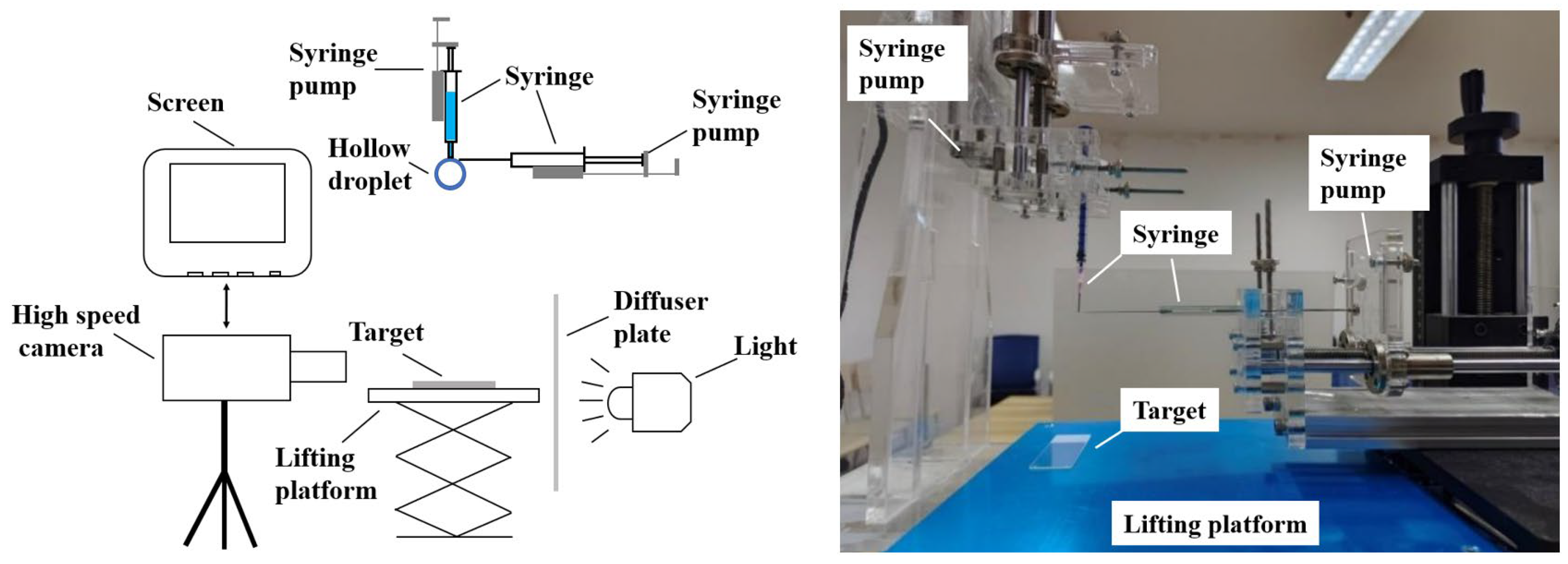
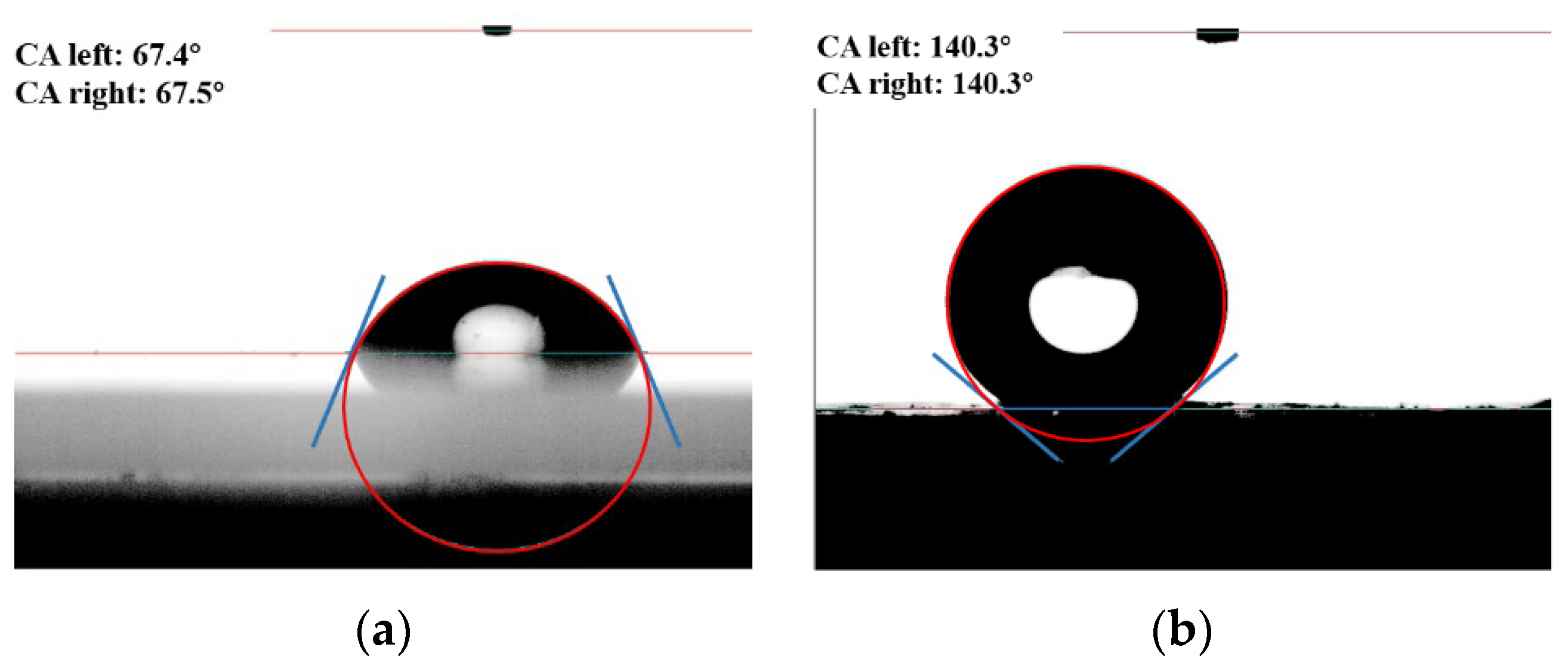
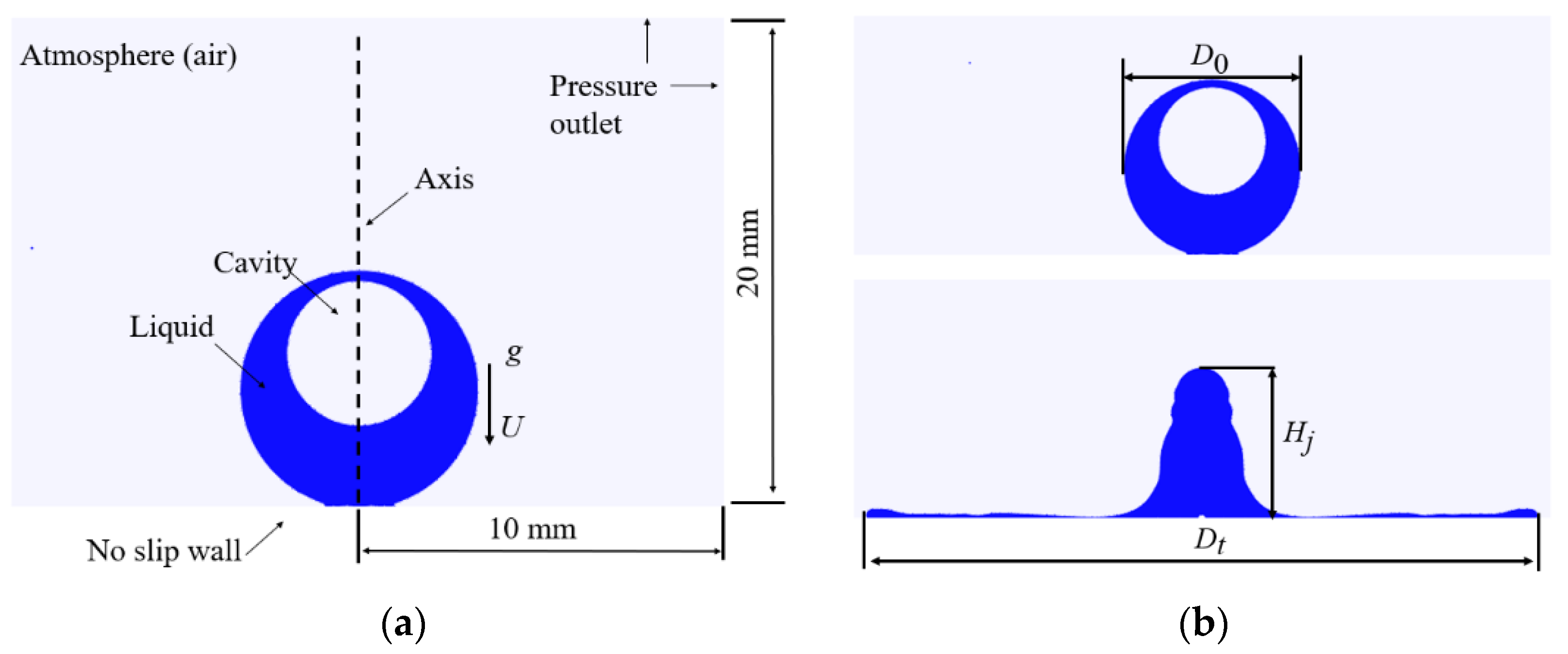
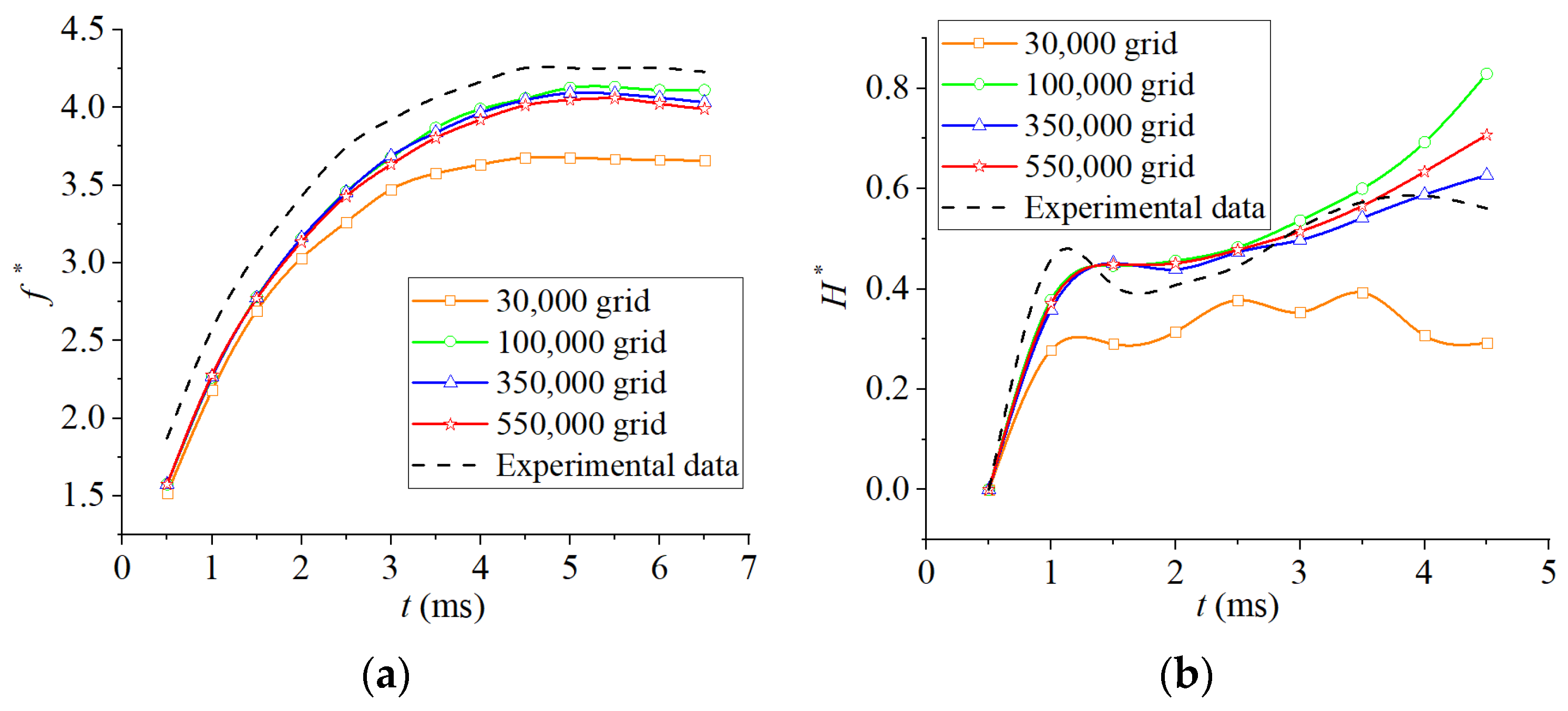

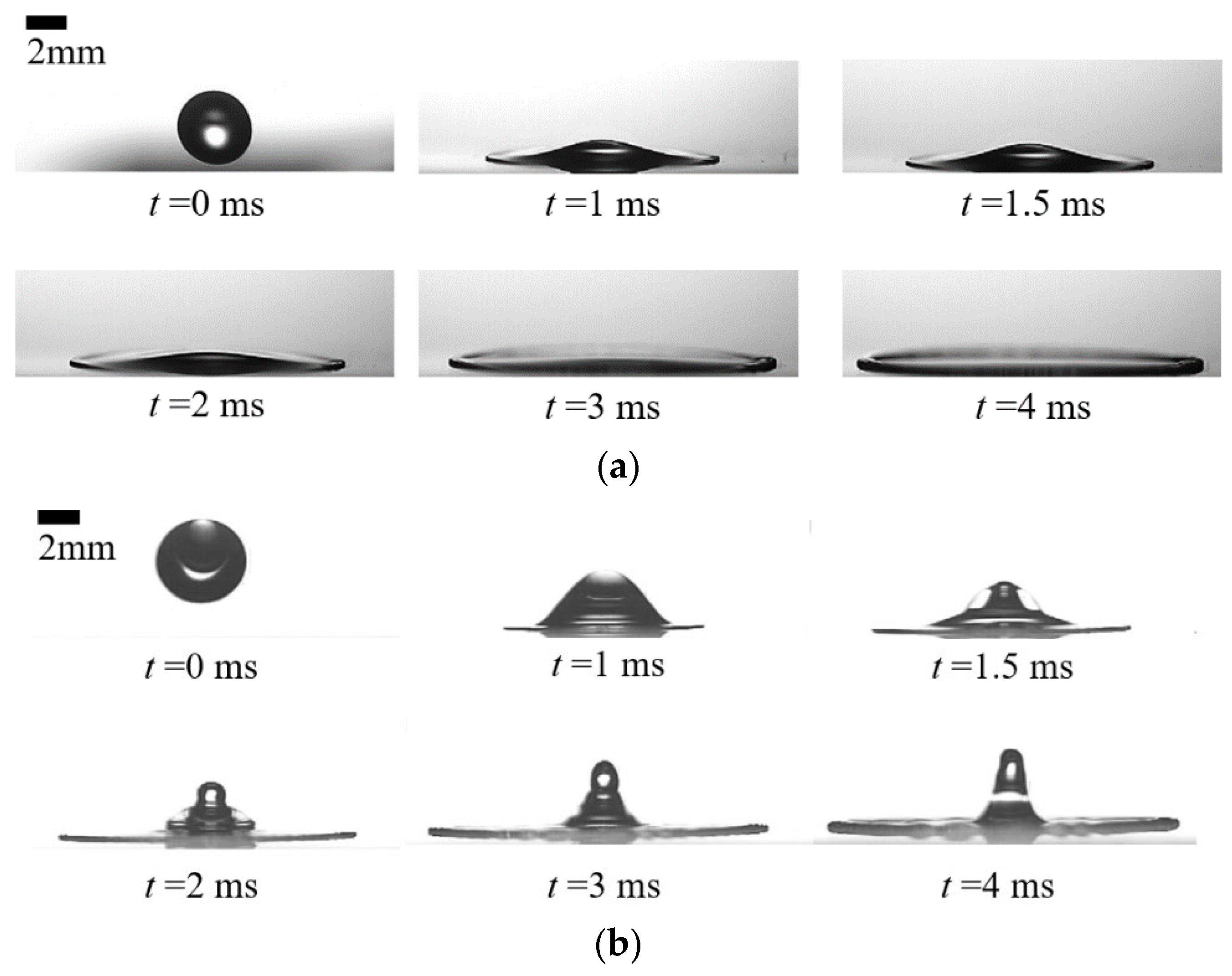
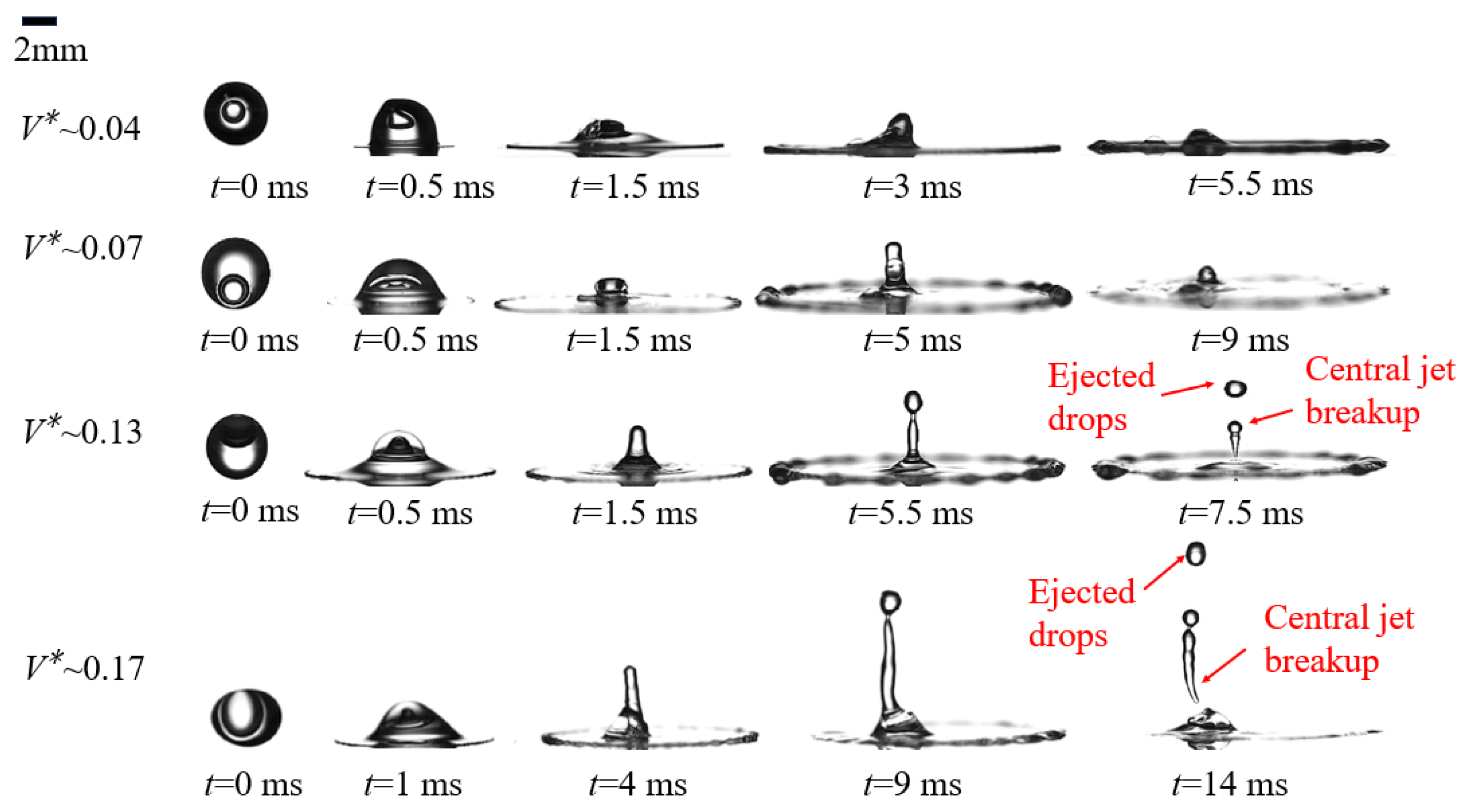
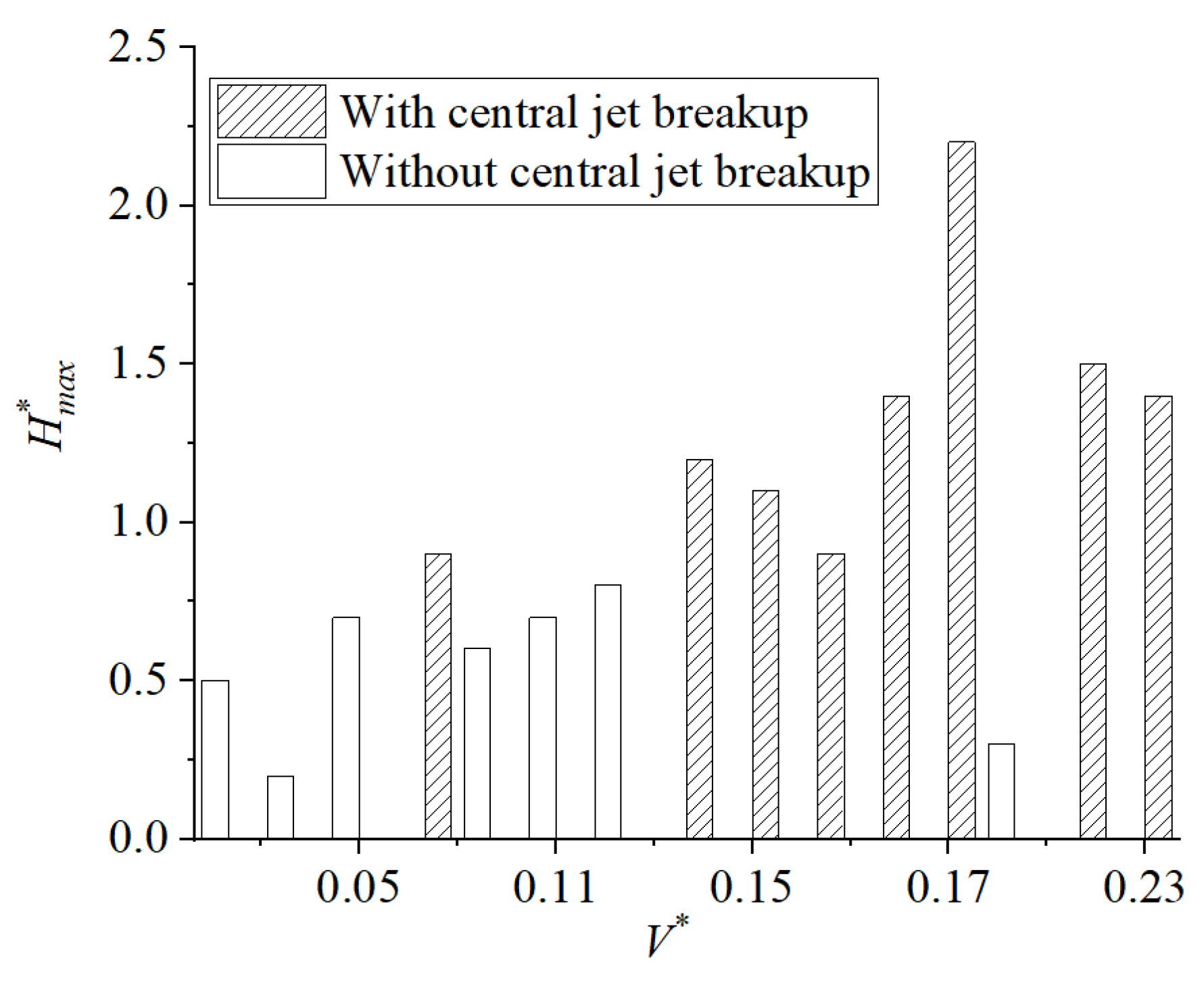
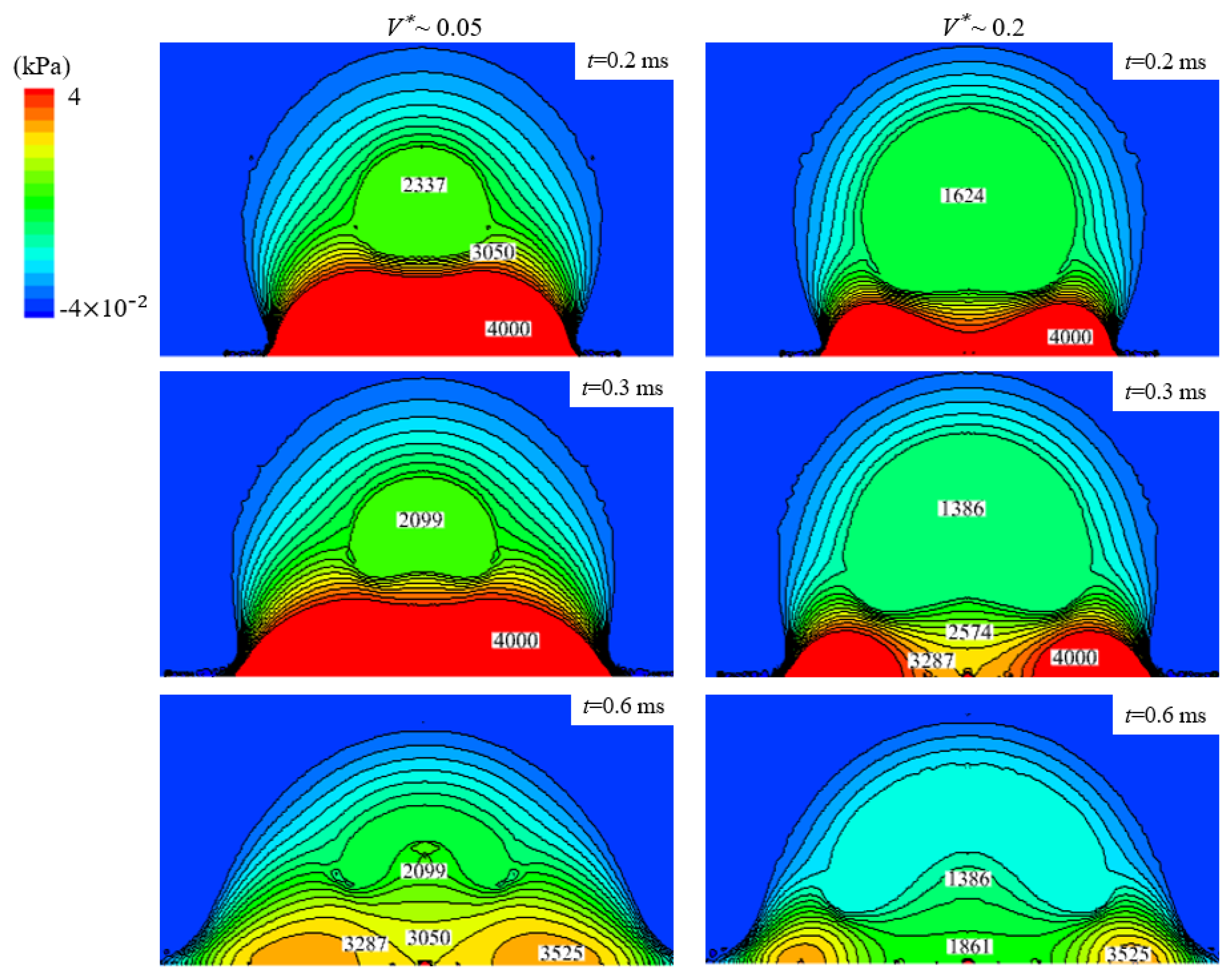

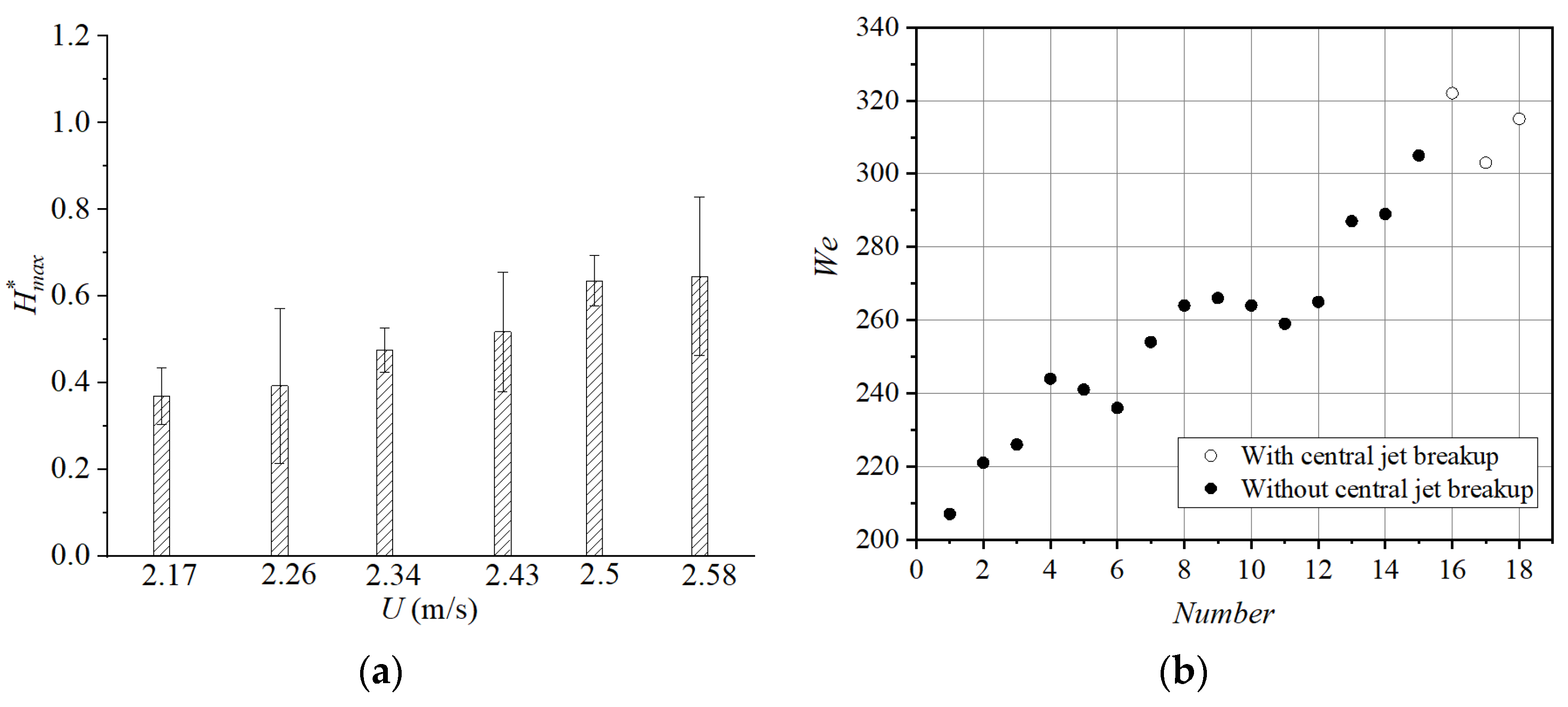

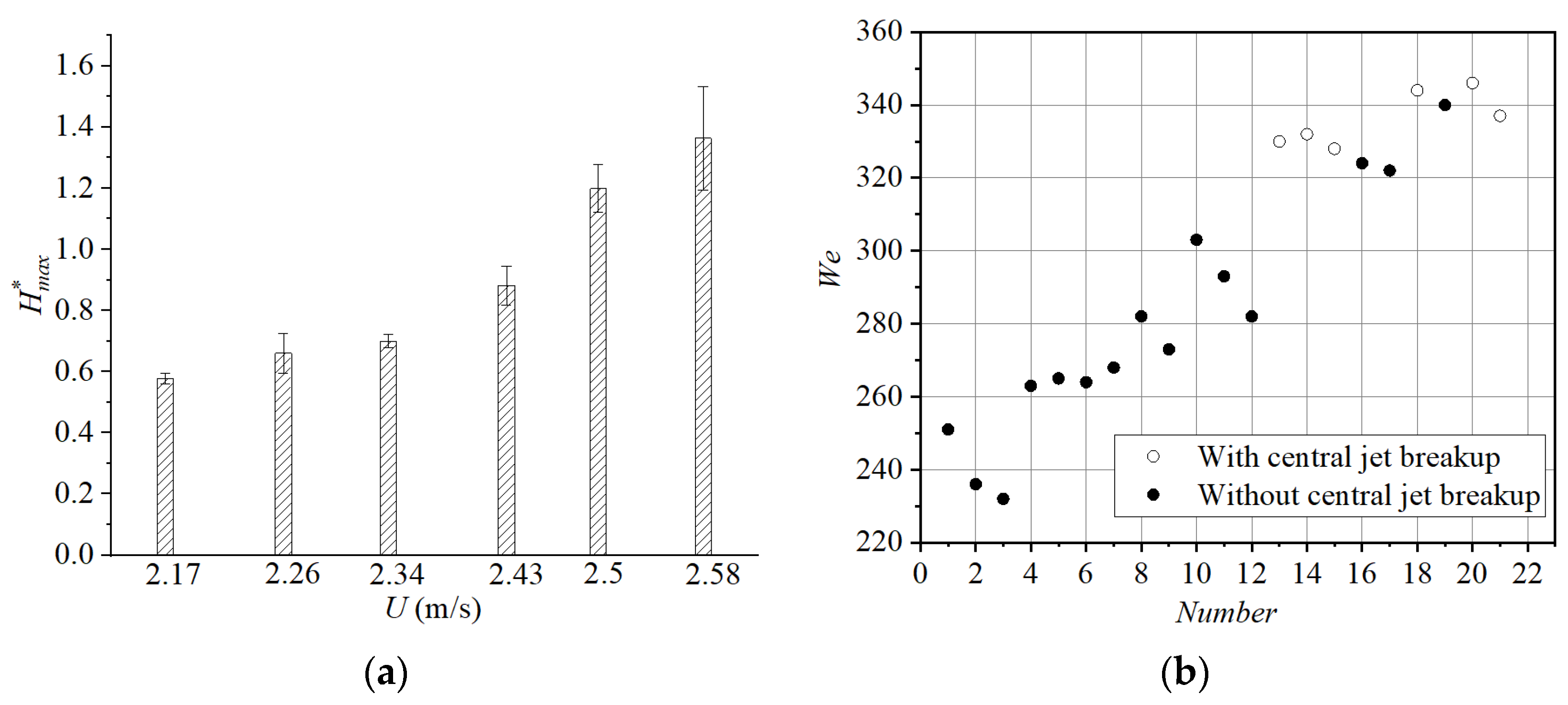
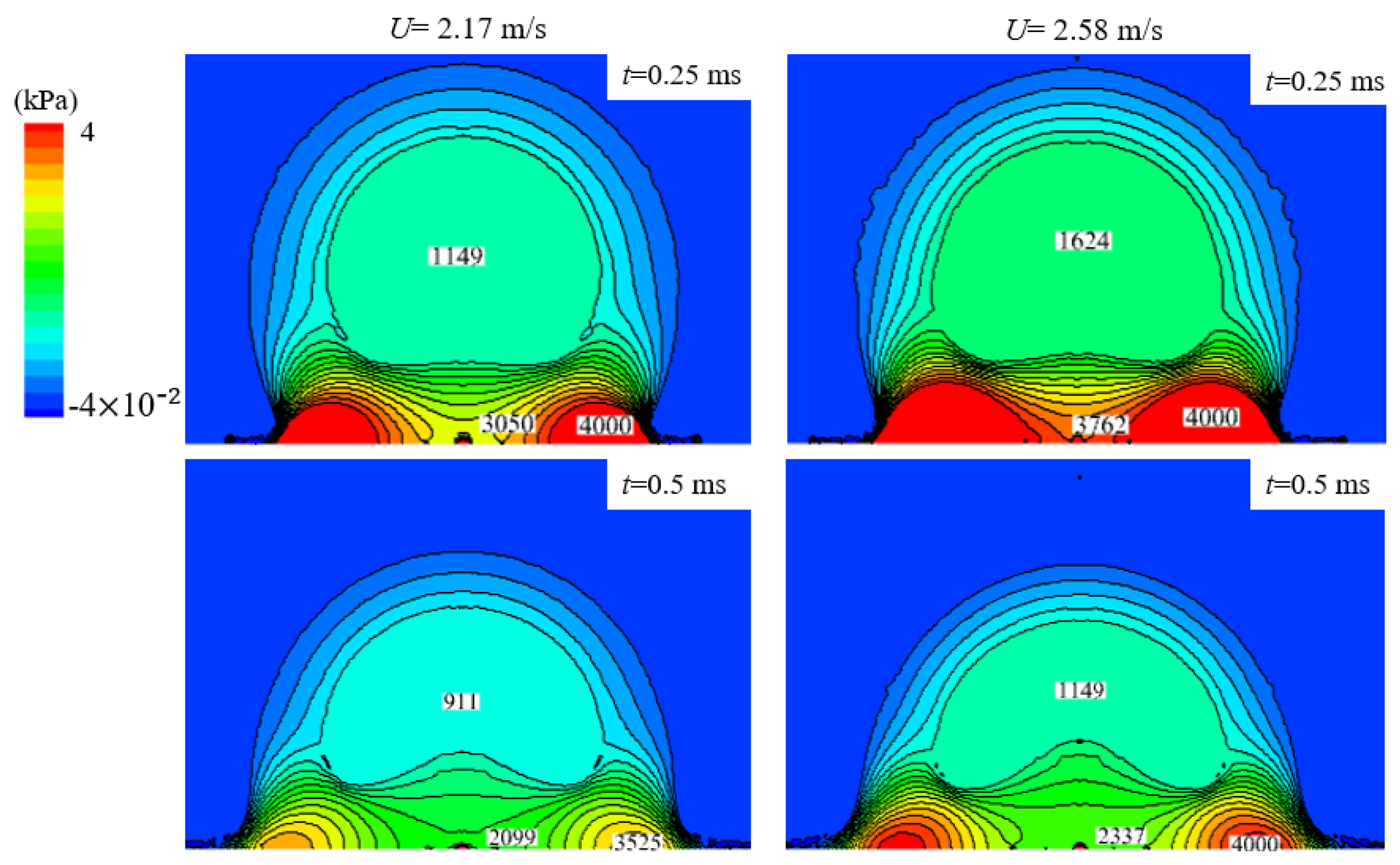
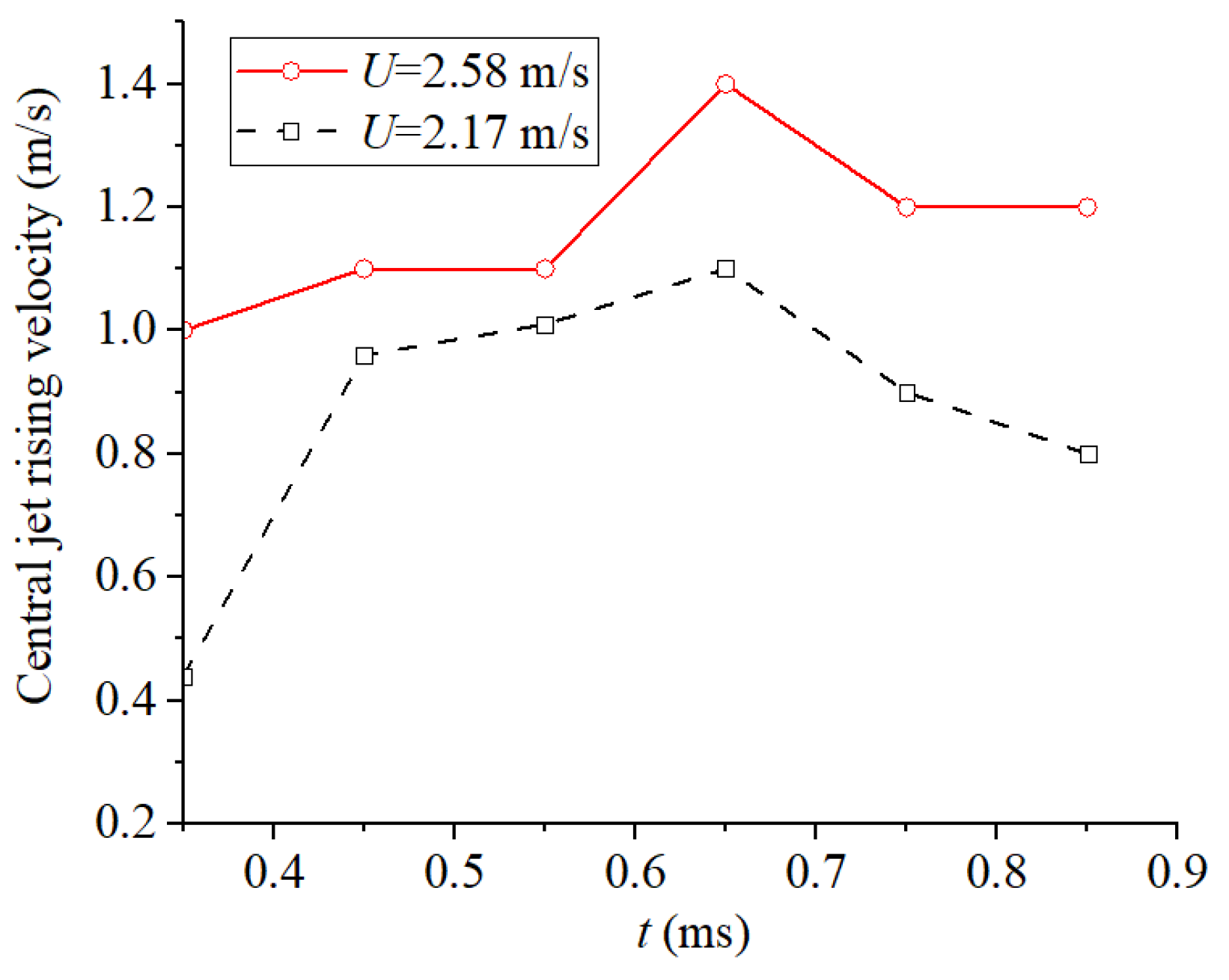
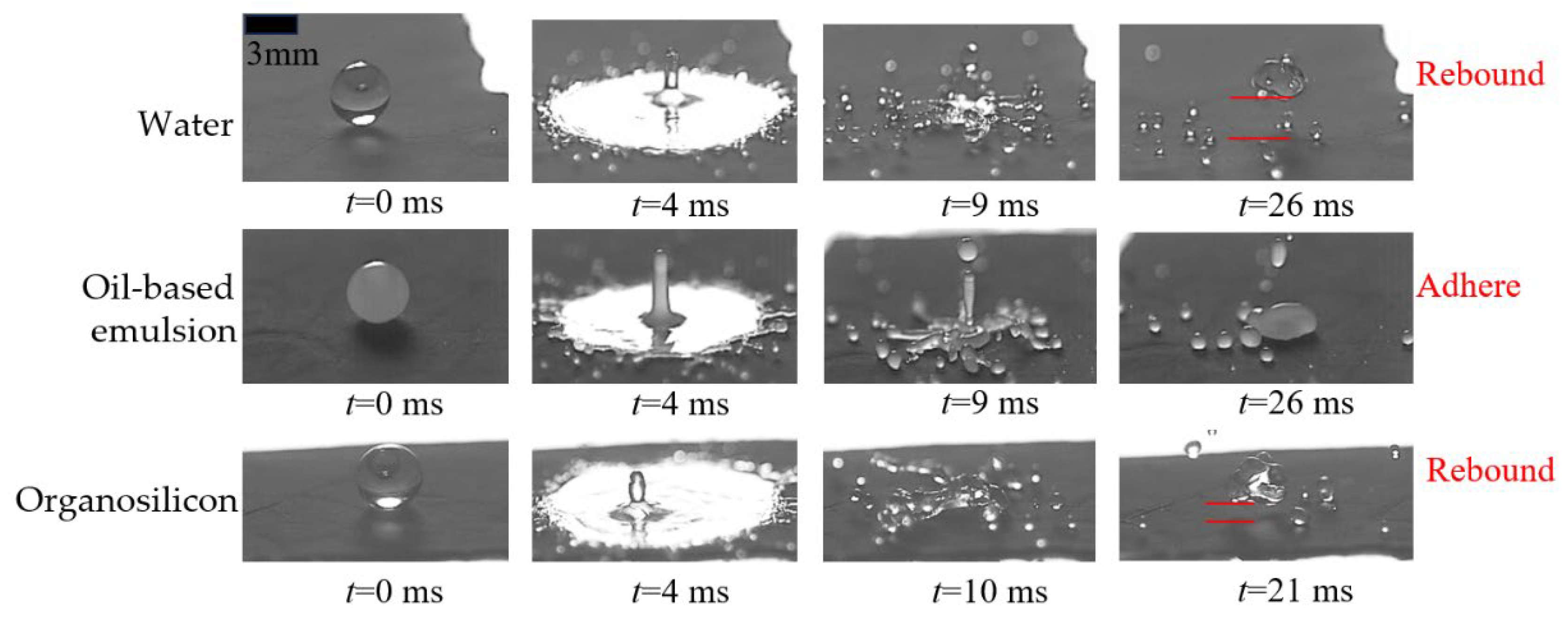
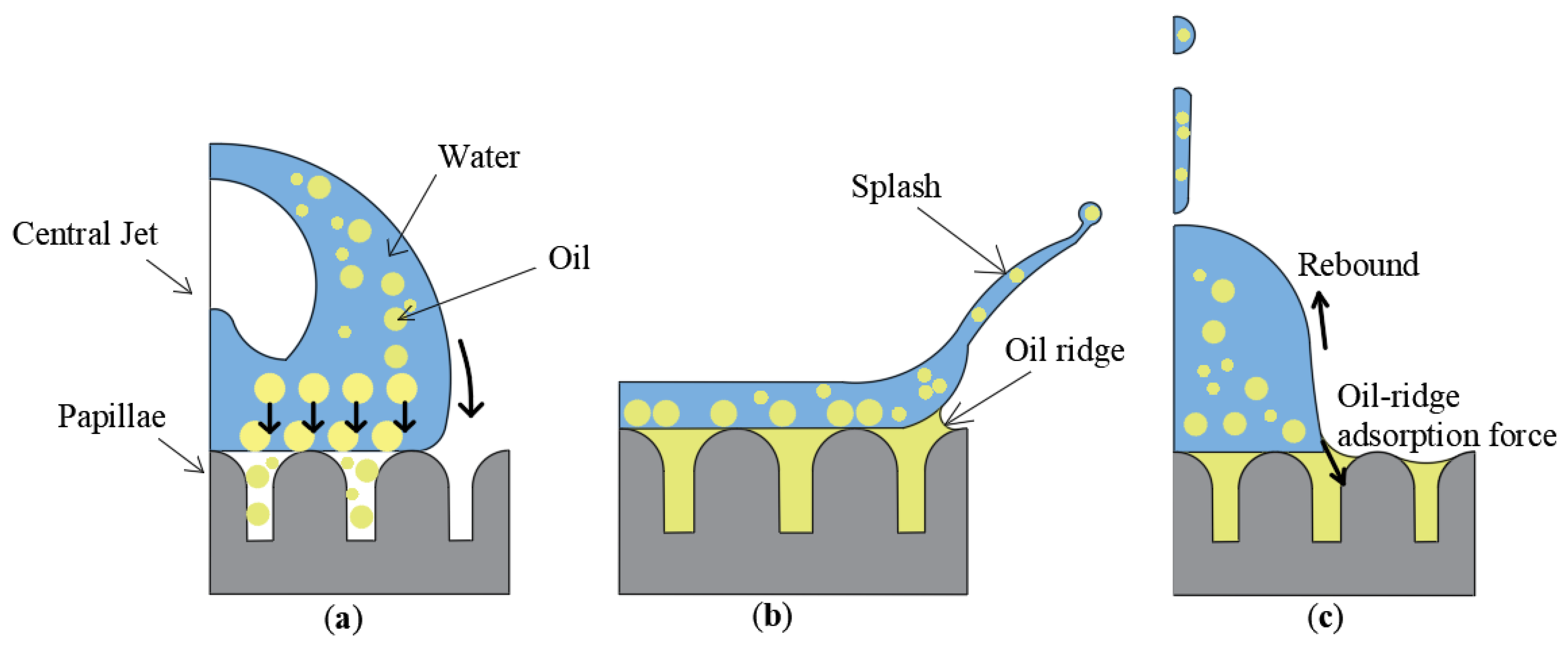

| Concentration | Static Surface Tension (mN/m) | Dynamic Viscosity (mPa·s) |
|---|---|---|
| 0% (W) | 72.14 | 0.83 |
| 0.8% (E) | 33.64 | 0.86 |
| 0.02% (O) | 31.10 | 0.80 |
Disclaimer/Publisher’s Note: The statements, opinions and data contained in all publications are solely those of the individual author(s) and contributor(s) and not of MDPI and/or the editor(s). MDPI and/or the editor(s) disclaim responsibility for any injury to people or property resulting from any ideas, methods, instructions or products referred to in the content. |
© 2024 by the authors. Licensee MDPI, Basel, Switzerland. This article is an open access article distributed under the terms and conditions of the Creative Commons Attribution (CC BY) license (https://creativecommons.org/licenses/by/4.0/).
Share and Cite
Gong, C.; Jia, F.; Kang, C. Deposition of Water and Emulsion Hollow Droplets on Hydrophilic and Hydrophobic Surfaces. Agriculture 2024, 14, 960. https://doi.org/10.3390/agriculture14060960
Gong C, Jia F, Kang C. Deposition of Water and Emulsion Hollow Droplets on Hydrophilic and Hydrophobic Surfaces. Agriculture. 2024; 14(6):960. https://doi.org/10.3390/agriculture14060960
Chicago/Turabian StyleGong, Chen, Feng Jia, and Can Kang. 2024. "Deposition of Water and Emulsion Hollow Droplets on Hydrophilic and Hydrophobic Surfaces" Agriculture 14, no. 6: 960. https://doi.org/10.3390/agriculture14060960
APA StyleGong, C., Jia, F., & Kang, C. (2024). Deposition of Water and Emulsion Hollow Droplets on Hydrophilic and Hydrophobic Surfaces. Agriculture, 14(6), 960. https://doi.org/10.3390/agriculture14060960








